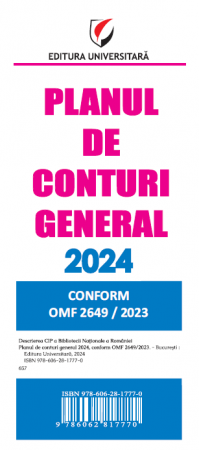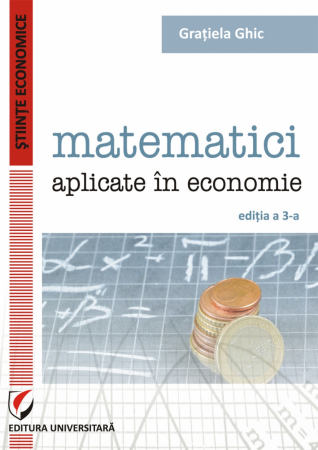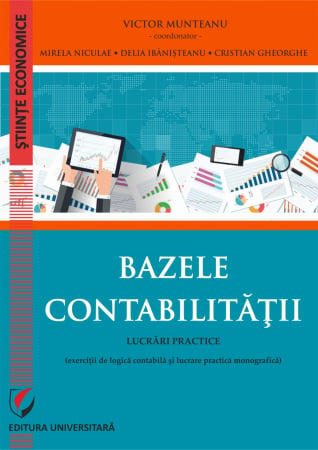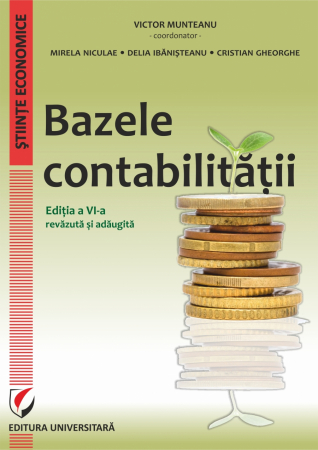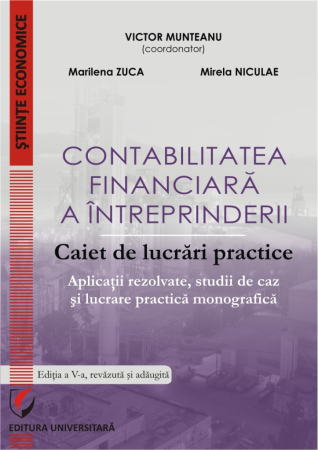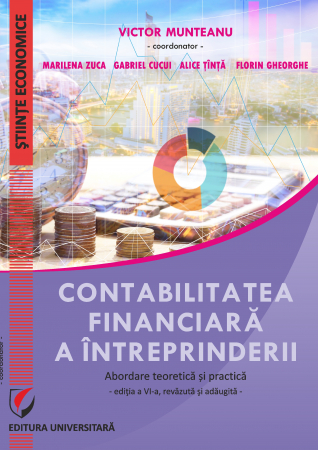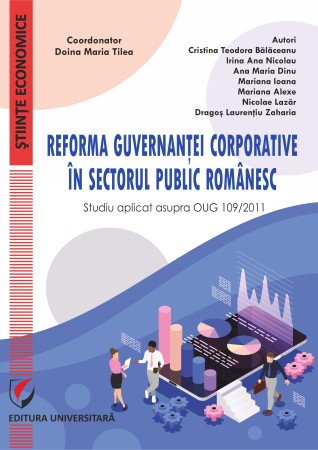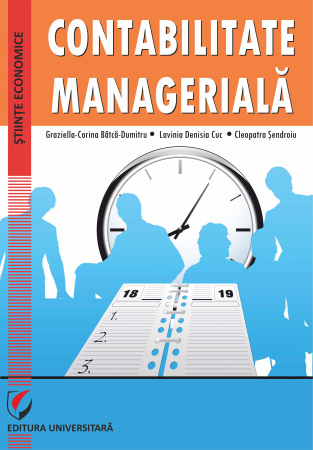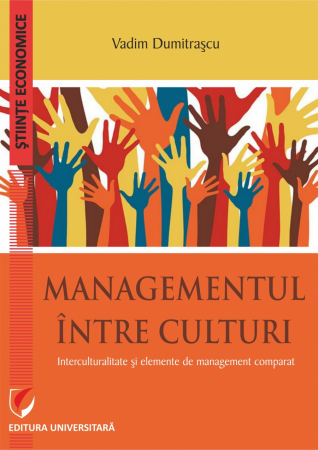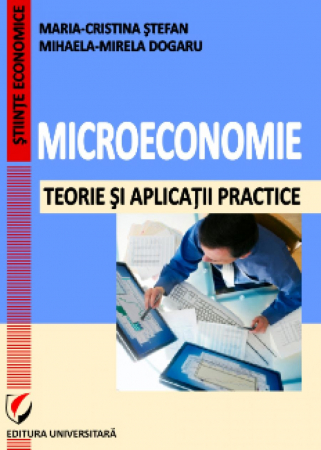Manuscript proposals: [email protected] / 0745 204 115 //// Tracking orders Individuals / Sales: 0745 200 357 / Orders Legal entities: 0721 722 783
ISBN: 978-606-591-840-5
DOI: 10.5682/9786065918405
Publisher year: 2013
Edition: I
Pages: 244
Publisher: Editura Universitară
Author: Sorinel Capusneanu
Product Code:
9786065918405
Do you need help?
0745 200 357
- Description
- Download (1)
- Authors
- Content
- More details
- Reviews (0)
The paper “Management accounting. Performance evaluation tool" aims to detail some theoretical and methodological aspects of management accounting and cost calculation, offering practical solutions to specialists, managers, students and master students who follow the specialization courses" Accounting and Management Informatics "," Managerial Accounting ", "Financial Management and Audit", as well as to all those interested in deepening the concepts of this discipline.
The concepts, ideas, applications considered in this paper are based on experience gained through doctoral and specialized studies conducted in collaboration with specialists and university professors in the field of management accounting, studies that have been published in various journals, both from country, as well as from abroad, and which allowed the author to expand his area of knowledge and deepening of various issues related to management accounting and cost calculation.
The concepts, ideas, applications considered in this paper are based on experience gained through doctoral and specialized studies conducted in collaboration with specialists and university professors in the field of management accounting, studies that have been published in various journals, both from country, as well as from abroad, and which allowed the author to expand his area of knowledge and deepening of various issues related to management accounting and cost calculation.
-
Contabilitatea de gestiune. Instrument de evaluare a performantei
Download
SORINEL CAPUSNEANU
Preface / 7
Chapter 1
Current conceptual approaches to management accounting / 9
1.1. Management accounting. Definition and objectives / 9
1.2. Functions of management accounting / 12
1.3. The role of management accounting / 15
1.4. Similarities and differences between management accounting and financial accounting / 16
Chapter 2
The general framework of the normalization of management accounting in Romania / 17
2.1. General framework of international and national standardization of management accounting / 17
2.2. Normalization of management accounting in Romania / 18
2.3. Management accounting management / 20
2.4. Profile and attributions of the management accountant / 21
2.5. What option for organizing management accounting do we opt for? / 21
2.5.1. Presentation of the economic content and the accounting function of the accounts from class 9 „Management accounts” / 24
2.6. Management accounting document system / 26
2.7. The premises for organizing management accounting and cost calculation / 27
2.8. Principles of management accounting and cost calculation / 29
2.9. Factors for organizing management accounting / 30
Chapter 3
Expenditure structure. Procedures for determining, delimiting and allocating expenses / 35
3.1. The notion of expenditure / 35
3.2. Expenditure structure / 36
3.3. Expenditure classification criteria / 36
3.4. Procedures for determining, delimiting and allocating expenses / 39
3.4.1. Procedures for delimiting the expenses on carriers and on places of expenses / 39
3.4.2. Procedures for separating indirect production costs into: variable and fixed / 44
3.4.3. Procedures for allocating indirect expenses of places of expenditure to cost bearers / 49
Chapter 4
Its cost and structure. Procedures for calculating unit costs / 58
4.1. Conceptual approaches to costs / 58
4.2. Cost structure. Object of cost study / 60
4.3. Cost classification criteria / 60
4.4. Interdependent manufacturing production calculation procedures / 72
4.5. Procedures for calculating the cost per unit of product / 77
4.5.1. The simple division procedure / 77
4.5.2. Quantitative procedure / 78
4.5.3. The procedure of equivalence indices / 79
4.5.4. Process for equivalence of the by - product with the main product / 92
4.5.5. Remaining value procedure / 93
Chapter 5
Management accounting methods and cost calculation / 96
5.1. The concept of costing method. Classification of cost calculation methods / 96
5.2. SWOT analysis of the cost calculation method / 97
5.3 Absorbent methods (full-costing) / 98
5.3.1. Classical methods / 98
5.3.1.1. Global method / 98
5.3.1.2. Phase method / 107
5.3.1.3. Command method / 125
5.3.1.4. Advantages and disadvantages of classical absorbent methods / 140
5.3.1.5. Standard-Cost Accounting Method / 141
5.3.1.6. SWOT analysis of the Standard-Cost Accounting / 150 method
5.3.2. Modern methods of cost calculation. ABC (Activity-Based Costing) method / 151
5.3.2.1. Overview of the ABC / 151 method
5.3.2.2. Pre-calculation of costs by the ABC / 154 method
5.3.2.3. Postcalculation of costs by the ABC / 164 method
5.3.2.4. Adaptation of the general chart of accounts to the ABC method. Methodological steps / 167
5.3.2.5. SWOT analysis of the ABC (Activity-Based Costing) / 181 method
5.3.3. Target Costing Method / 182
5.3.3.1. General presentation / 182
5.3.3.2. Steps of the Target-Costing method / 184
5.3.3.3. Adaptation of the general chart of accounts to the Target-Costing method. Methodological steps / 185
5.3.3.4. SWOT analysis of the Target-Costing method / 194
5.4. Partial-costing methods / 195
5.4.1. Direct-Costing method / 195
5.4.2. Indicators specific to the Direct-Costing method / 196
5.4.2.1. Direct-Costing Method. Simplified version / 197
5.4.2.2. Direct-Costing method. Evolved variant / 201
5.4.2.3. Direct-Costing method. Calculation of coverage of fixed expenses / 204
5.4.3. SWOT analysis of the Direct-Costing / 215 method
Chapter 6
Ways of reporting information from management accounting / 217
6.1. Accounting summary documents / 217
6.1.1. Income statement / 218
6.1.2. Other analysis situations / 222
6.1.2.1. Situation of deviations / 222
6.1.2.2. Objective-oriented situations / 223
6.1.2.2.1. Dashboard ABC / 226
6.1.2.2.2. Balanced dashboard / 230
6.1.2.2.3. Comparative analysis / 233
6.1.2.2.4. Cost-volume-profit analysis / 234
6.2. Advantages and disadvantages of the components of synthesis documents / 238
6.3. Conclusions and recommendations for future research / 239
Bibliography / 240
Chapter 1
Current conceptual approaches to management accounting / 9
1.1. Management accounting. Definition and objectives / 9
1.2. Functions of management accounting / 12
1.3. The role of management accounting / 15
1.4. Similarities and differences between management accounting and financial accounting / 16
Chapter 2
The general framework of the normalization of management accounting in Romania / 17
2.1. General framework of international and national standardization of management accounting / 17
2.2. Normalization of management accounting in Romania / 18
2.3. Management accounting management / 20
2.4. Profile and attributions of the management accountant / 21
2.5. What option for organizing management accounting do we opt for? / 21
2.5.1. Presentation of the economic content and the accounting function of the accounts from class 9 „Management accounts” / 24
2.6. Management accounting document system / 26
2.7. The premises for organizing management accounting and cost calculation / 27
2.8. Principles of management accounting and cost calculation / 29
2.9. Factors for organizing management accounting / 30
Chapter 3
Expenditure structure. Procedures for determining, delimiting and allocating expenses / 35
3.1. The notion of expenditure / 35
3.2. Expenditure structure / 36
3.3. Expenditure classification criteria / 36
3.4. Procedures for determining, delimiting and allocating expenses / 39
3.4.1. Procedures for delimiting the expenses on carriers and on places of expenses / 39
3.4.2. Procedures for separating indirect production costs into: variable and fixed / 44
3.4.3. Procedures for allocating indirect expenses of places of expenditure to cost bearers / 49
Chapter 4
Its cost and structure. Procedures for calculating unit costs / 58
4.1. Conceptual approaches to costs / 58
4.2. Cost structure. Object of cost study / 60
4.3. Cost classification criteria / 60
4.4. Interdependent manufacturing production calculation procedures / 72
4.5. Procedures for calculating the cost per unit of product / 77
4.5.1. The simple division procedure / 77
4.5.2. Quantitative procedure / 78
4.5.3. The procedure of equivalence indices / 79
4.5.4. Process for equivalence of the by - product with the main product / 92
4.5.5. Remaining value procedure / 93
Chapter 5
Management accounting methods and cost calculation / 96
5.1. The concept of costing method. Classification of cost calculation methods / 96
5.2. SWOT analysis of the cost calculation method / 97
5.3 Absorbent methods (full-costing) / 98
5.3.1. Classical methods / 98
5.3.1.1. Global method / 98
5.3.1.2. Phase method / 107
5.3.1.3. Command method / 125
5.3.1.4. Advantages and disadvantages of classical absorbent methods / 140
5.3.1.5. Standard-Cost Accounting Method / 141
5.3.1.6. SWOT analysis of the Standard-Cost Accounting / 150 method
5.3.2. Modern methods of cost calculation. ABC (Activity-Based Costing) method / 151
5.3.2.1. Overview of the ABC / 151 method
5.3.2.2. Pre-calculation of costs by the ABC / 154 method
5.3.2.3. Postcalculation of costs by the ABC / 164 method
5.3.2.4. Adaptation of the general chart of accounts to the ABC method. Methodological steps / 167
5.3.2.5. SWOT analysis of the ABC (Activity-Based Costing) / 181 method
5.3.3. Target Costing Method / 182
5.3.3.1. General presentation / 182
5.3.3.2. Steps of the Target-Costing method / 184
5.3.3.3. Adaptation of the general chart of accounts to the Target-Costing method. Methodological steps / 185
5.3.3.4. SWOT analysis of the Target-Costing method / 194
5.4. Partial-costing methods / 195
5.4.1. Direct-Costing method / 195
5.4.2. Indicators specific to the Direct-Costing method / 196
5.4.2.1. Direct-Costing Method. Simplified version / 197
5.4.2.2. Direct-Costing method. Evolved variant / 201
5.4.2.3. Direct-Costing method. Calculation of coverage of fixed expenses / 204
5.4.3. SWOT analysis of the Direct-Costing / 215 method
Chapter 6
Ways of reporting information from management accounting / 217
6.1. Accounting summary documents / 217
6.1.1. Income statement / 218
6.1.2. Other analysis situations / 222
6.1.2.1. Situation of deviations / 222
6.1.2.2. Objective-oriented situations / 223
6.1.2.2.1. Dashboard ABC / 226
6.1.2.2.2. Balanced dashboard / 230
6.1.2.2.3. Comparative analysis / 233
6.1.2.2.4. Cost-volume-profit analysis / 234
6.2. Advantages and disadvantages of the components of synthesis documents / 238
6.3. Conclusions and recommendations for future research / 239
Bibliography / 240
The paper “Management accounting. Performance evaluation tool" aims to detail some theoretical and methodological aspects of management accounting and cost calculation, offering practical solutions to specialists, managers, students and master students who follow the specialization courses" Accounting and Management Informatics "," Managerial Accounting ", "Financial Management and Audit", as well as to all those interested in deepening the concepts of this discipline.
The concepts, ideas, applications considered in this paper are based on experience gained through doctoral and specialized studies conducted in collaboration with specialists and university professors in the field of management accounting, studies that have been published in various journals, both from country, as well as from abroad, and which allowed the author to expand his area of knowledge and deepening of various issues related to management accounting and cost calculation.
The paper begins with a description of the current concepts of management accounting, presenting various definitions, objectives, functions and role of management accounting and cost calculation. The similarities and differences between financial and management accounting are also presented. Next, the author describes the general framework of the normalization of management accounting in Romania, the profile and attributions of the management accountant, as well as the document system used. In a simplistic manner, the author describes the premises, factors and principles of organization of management accounting and cost calculation. This chapter stands out through the presentation and general analysis of the management accounts system in our country, analyzing the causes of existing deficiencies and trying to propose solutions to improve the methods used in Romania compared to other advanced methods of management accounting and cost calculation.
By debating the notion of expenditure and the specific criteria for classifying expenditures, including the procedures for determining, delimiting and allocating expenditures, the author tries to establish the general framework necessary to determine the cost of production. The treatment of costs in the national and international literature is captured in a Management Accounting. The tool for evaluating the performance of another chapter of this paper, this being accompanied by the presentation of the calculation procedures per product unit and of the interdependent manufacturing production.
A special chapter is dedicated to management accounting and costing methods that address this concept and proposes a classification of costing methods starting from the two main categories, namely: full-costing methods and methods partial-costing. Thus, total type methods were described and analyzed, such as: global method, phase method, order method, standard cost method, activity cost calculation method, target cost method, but also partial type method as variable cost method. In order to facilitate the understanding of the theoretical aspects debated, the paper is accompanied by numerous examples that have highlighted the ways of accounting and cost analysis and the advantages and disadvantages of each method. These applied studies are based on the latest appearances of theoretical and practical works published by prestigious university professors in our country, but also by some foreign authors who have contributed to the development of concepts, theories and methods, used more and more. in the specialized practice from which the beneficiaries are the users of internal information, but also external ones.
The paper concludes with an exposition of ways of reporting information from management accounting and the creation of a set of accounting summary documents, such as the income statement and other analysis and reporting situations. These proposals, accompanied by practical examples based on an intense theoretical and practical documentation, are followed by the presentation of the advantages and disadvantages of the accounting summary documents.
The material used in this paper is in the process of improvement and completion with other elements useful for understanding the specific notions of management accounting and cost calculation. Certainly some of the issues addressed are elliptical in terms of theoretical presentation, but we hope that they are mitigated after reviewing the examples and case studies.
The bibliography on which this paper is based is presented, selectively at the end and offers the possibility of deepening knowledge for those interested.
Prof. univ. Dr. Sorin BRICIU
The concepts, ideas, applications considered in this paper are based on experience gained through doctoral and specialized studies conducted in collaboration with specialists and university professors in the field of management accounting, studies that have been published in various journals, both from country, as well as from abroad, and which allowed the author to expand his area of knowledge and deepening of various issues related to management accounting and cost calculation.
The paper begins with a description of the current concepts of management accounting, presenting various definitions, objectives, functions and role of management accounting and cost calculation. The similarities and differences between financial and management accounting are also presented. Next, the author describes the general framework of the normalization of management accounting in Romania, the profile and attributions of the management accountant, as well as the document system used. In a simplistic manner, the author describes the premises, factors and principles of organization of management accounting and cost calculation. This chapter stands out through the presentation and general analysis of the management accounts system in our country, analyzing the causes of existing deficiencies and trying to propose solutions to improve the methods used in Romania compared to other advanced methods of management accounting and cost calculation.
By debating the notion of expenditure and the specific criteria for classifying expenditures, including the procedures for determining, delimiting and allocating expenditures, the author tries to establish the general framework necessary to determine the cost of production. The treatment of costs in the national and international literature is captured in a Management Accounting. The tool for evaluating the performance of another chapter of this paper, this being accompanied by the presentation of the calculation procedures per product unit and of the interdependent manufacturing production.
A special chapter is dedicated to management accounting and costing methods that address this concept and proposes a classification of costing methods starting from the two main categories, namely: full-costing methods and methods partial-costing. Thus, total type methods were described and analyzed, such as: global method, phase method, order method, standard cost method, activity cost calculation method, target cost method, but also partial type method as variable cost method. In order to facilitate the understanding of the theoretical aspects debated, the paper is accompanied by numerous examples that have highlighted the ways of accounting and cost analysis and the advantages and disadvantages of each method. These applied studies are based on the latest appearances of theoretical and practical works published by prestigious university professors in our country, but also by some foreign authors who have contributed to the development of concepts, theories and methods, used more and more. in the specialized practice from which the beneficiaries are the users of internal information, but also external ones.
The paper concludes with an exposition of ways of reporting information from management accounting and the creation of a set of accounting summary documents, such as the income statement and other analysis and reporting situations. These proposals, accompanied by practical examples based on an intense theoretical and practical documentation, are followed by the presentation of the advantages and disadvantages of the accounting summary documents.
The material used in this paper is in the process of improvement and completion with other elements useful for understanding the specific notions of management accounting and cost calculation. Certainly some of the issues addressed are elliptical in terms of theoretical presentation, but we hope that they are mitigated after reviewing the examples and case studies.
The bibliography on which this paper is based is presented, selectively at the end and offers the possibility of deepening knowledge for those interested.
Prof. univ. Dr. Sorin BRICIU
If you want to express your opinion about this product you can add a review.
write a review

6359.png)
![Management Accounting. Performance Assessment Tool [1] Management Accounting. Performance Assessment Tool [1]](https://gomagcdn.ro/domains/editurauniversitara.ro/files/product/large/contabilitatea-de-gestiune-instrument-de-evaluare-a-performantei-1239-100527.jpg)
